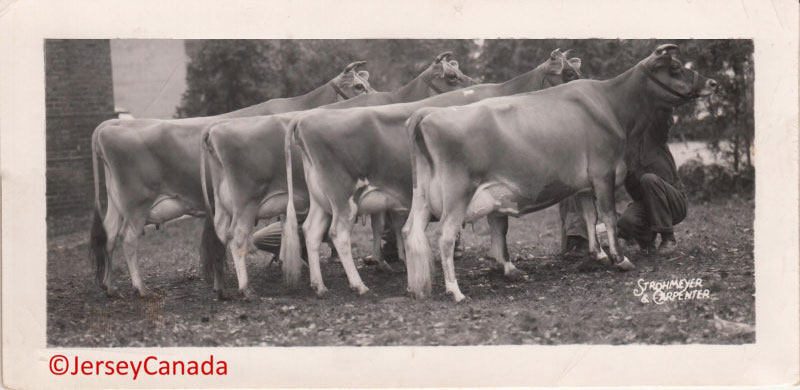JERSEY HISTORY
CANADIAN JERSEY HISTORY
Jerseys first came to Canada in 1868 to the province of Quebec. The American Jersey Cattle Club provided registry services to Jersey owners and breeders in Canada until the Canadian Association (established in 1901) began its own herd book in 1905. The breed has known periods of growth, expansion and retreat over the past century. Markets for All-Jersey milk were created and caused a great burst of interest in the breed in the late 1950's and early 1960's. When pooling of milk was introduced in the 1960's the breed went through a period of decline in activity with the loss of specialized markets for milk. Many dedicated Jersey owners maintained their interest in the breed and kept profitable animals during this 'low time' for the breed. In the 1980's a push for greater productivity began and the fortunes of the breed turned around. Higher production coupled with the introduction Multiple Component Pricing has led to an ever-increasing level of demand for Jerseys. Over the past two decades scores of records for high production and sale ring prices have been set and re-set with regularity.
Jerseys from Canada have always been in strong demand. The breed is versatile and responsive and thus is well able to keep up with changing times and requirements. In recent years, there has been a renewed domestic market for Jerseys, due partially to changes in milk pricing across Canada to favour production of butterfat, along with the many other production efficiencies that the breed possesses.
Jersey Canada has seen a dramatic increase in the number of new members of the association, with substantial increases in the percentage of Canadian dairy herds having at least some Jerseys. Membership is at the highest levels since the late 1960's, and registration numbers are also trending upward. This is no doubt due in part to a sizeable increase in the number of Jerseys in embryo collection and transfer programs.
Jerseys from Canada have always been in strong demand. The breed is versatile and responsive and thus is well able to keep up with changing times and requirements. In recent years, there has been a renewed domestic market for Jerseys, due partially to changes in milk pricing across Canada to favour production of butterfat, along with the many other production efficiencies that the breed possesses.
Jersey Canada has seen a dramatic increase in the number of new members of the association, with substantial increases in the percentage of Canadian dairy herds having at least some Jerseys. Membership is at the highest levels since the late 1960's, and registration numbers are also trending upward. This is no doubt due in part to a sizeable increase in the number of Jerseys in embryo collection and transfer programs.
GENERAL HISTORY
The Jersey breed was developed on Jersey Island, one of a series of small Channel Islands in the channel between England and France, just off the coast of Normandy, France. Jersey Island is about forty five square miles and is renowned as a tourism and banking center, for its remarkable Jersey Royal potatoes and, of course, for the Jersey cow. Sixty years ago there were over 1,000 properties on this small island where at least a couple of Jersey cows would be kept. Today there are less than 30 functioning farms some of which are quite large and modern.
It is theorized that some of the foundation genetics for the Jersey breed came from Africa. This would explain why the breed exhibits strong tolerance to heat and high humidity conditions. For over 200 years the importation of any live bovines, semen or embryos has been restricted on Jersey. This could well explain why the breed is noted for its ability to “breed true” to type. In July 2008, the ban on semen imports to Jersey Island was lifted.
On Jersey Island the dairy rations were primarily forage-based, thus requiring a cow that could efficiently convert grasses and legumes into milk and milk solids. Jersey owners placed emphasis on developing a breed of cows with very high solids levels in her milk. This selection over generations has created a cow with extraordinary levels of butterfat relative to the other common breeds of dairy cattle today.
For much of the first six decades of the 20th century, Jersey Island was the source of breeding stock to start Jersey populations all over the globe. The breed has been particularly noteworthy in New Zealand, Australia, Denmark, the United States, South Africa, Great Britain and Canada. In more recent times these countries have been the source of seed stock for national Jersey herds in the Central and South American countries of Brazil, Guatemala, Argentina, Peru, Uruguay, Colombia, Venezuela and Costa Rica. Mexico has become a prominent importer and breeder of Jerseys as well. Populations of Jerseys are growing in France, Japan, Germany, Italy, the Netherlands, Switzerland and Kenya.

OUR HISTORIC TIMELINE
1901
Incorporated June 11, 1901 as the Canadian Jersey Cattle Breeders Association - Jerseys born in Canada were registered with the American Jersey Cattle Association
1905
Establishment of the Canadian Jersey herdbook
1945
1st edition of the Canadian Jersey Breeder publication
1950
Office located in Toronto, Ontario
1955
All Canadian contest established
1969
Master Breeder award launched
1973
Office moves to Waterloo Ave., Guelph, ON
1988
Name change to the Jersey Cattle Association of Canada
1990
Office moves to Speedvale Ave, Guelph, ON (current location)
1994
Name change to Jersey Canada
1999
Registry system moves in-house with state of the art software and on-line registration/recordation
2012
New website for Jersey Canada
2014
Economic Analysis of Dairy Breeds study released (U of G)
2015
The Canadian Jersey Breeder celebrates 70th anniversary
2016
Record number of Jersey registrations since 1967 and a 33% increase in transfers over 2016
2017
Launch of modernized logo and graphic tradeshow booth – registrations highest since 1965 and memberships highest since 1962

